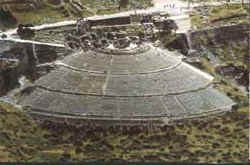The Great Theater
 The focal point of Ephesus is the great theatre, the largest in Asia
Minor, with a seating capacity of 24,000.İt dates from the early
Hellenistic period, with extensive additions and reconstructions in the
imperial Roman era. The auditorium extends through an angle of 220 Degrees
and has a diameter of 154 meters, with a vertical rise of 38 meters from
its orchestra to the uppermost tier of seats, whose middle section is
still surmounted by an arcade. Two diazomata divide the auditorium into
three section, the first of which have twelve radial stairways and the
third twenty four. The diameter of the orchestra, which is slightly
larger than a semicircle, is about 34 meters.
The focal point of Ephesus is the great theatre, the largest in Asia
Minor, with a seating capacity of 24,000.İt dates from the early
Hellenistic period, with extensive additions and reconstructions in the
imperial Roman era. The auditorium extends through an angle of 220 Degrees
and has a diameter of 154 meters, with a vertical rise of 38 meters from
its orchestra to the uppermost tier of seats, whose middle section is
still surmounted by an arcade. Two diazomata divide the auditorium into
three section, the first of which have twelve radial stairways and the
third twenty four. The diameter of the orchestra, which is slightly
larger than a semicircle, is about 34 meters.
The actors in ancient Greek drama originally performed
alongside the chorus in the orchestra; later in the Hellenistic period,
they acted on a raised stage, the proscenium, which was erected in front
of the Skene, the stage building. The core of the Hellenistic Skene in the
Ephesus theater remains Within the monumental stage building erected in
the Imperial Roman era. This grandiose structure originally had three
stories, with colonnaded frontals alternating with statues and relief's
set in niches; in front of it was the broad stage, raised high above the
level of the orchestra on three rows of Doric columns, whose stumps remain
in place.